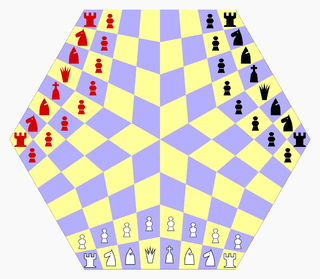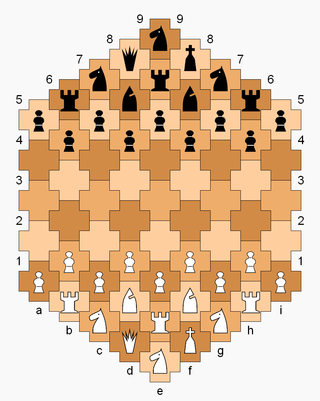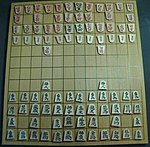A fairy chess piece, variant chess piece, unorthodox chess piece, or heterodox chess piece is a chess piece not used in conventional chess but incorporated into certain chess variants and some chess problems. Compared to conventional pieces, fairy pieces vary mostly in the way they move, but they may also follow special rules for capturing, promotions, etc. Because of the distributed and uncoordinated nature of unorthodox chess development, the same piece can have different names, and different pieces can have the same name in various contexts. Most are symbolised as inverted or rotated icons of the standard pieces in diagrams, and the meanings of these "wildcards" must be defined in each context separately. Pieces invented for use in chess variants rather than problems sometimes instead have special icons designed for them, but with some exceptions, many of these are not used beyond the individual games for which they were invented.

Hexagonal chess is a group of chess variants played on boards composed of hexagon cells. The best known is Gliński's variant, played on a symmetric 91-cell hexagonal board.
Chess with different armies is a chess variant invented by Ralph Betza in 1979. Two sides use different sets of fairy pieces. There are several armies of equal strength to choose from, including the standard FIDE army. In all armies, kings and pawns are the same as in FIDE chess, but the four other pieces are different.

Minichess is a family of chess variants played with regular chess pieces and standard rules, but on a smaller board. The motivation for these variants is to make the game simpler and shorter than standard chess. The first chess-like game implemented on a computer was the 6×6 chess variant Los Alamos chess. The low memory capacity of early computers meant that a reduced board size and a smaller number of pieces were required for the game to be implementable on a computer.
Three-player chess is a family of chess variants specially designed for three players. Many variations of three-player chess have been devised. They usually use a non-standard board, for example, a hexagonal or three-sided board that connects the center cells in a special way. The three armies are differentiated usually by color.

Dragonfly is a chess variant invented by Christian Freeling in 1983. There are no queens, and a captured bishop, knight, or rook becomes the property of the capturer, who may play it as their own on a turn to any open square. The board is 7×7 squares, or alternatively a 61-cell hexagon with two additional pawns per side.

Rhombic chess is a chess variant for two players created by Tony Paletta in 1980. The gameboard has an overall hexagonal shape and comprises 72 rhombi in three alternating colors. Each player commands a full set of standard chess pieces.

Triangular chess is a chess variant for two players invented by George R. Dekle Sr. in 1986. The game is played on a hexagon-shaped gameboard comprising 96 triangular cells. Each player commands a full set of chess pieces in addition to three extra pawns and a unicorn.
EuroShogi is a shogi variant invented by Vladimír Pribylinec starting in 2000. The game developed from an early version of chess variant Echos in 1977, leading to Cubic Chess, then later to Cubic Shogi, and finally to EuroShogi. Instead of the classic figures, 18 black and 18 white cubes are used, which are on two opposing sides without symbols. The other two cubes on the opposite sides have one white and one black symbol. The other opposing sides are the same symbols of the opposite color - their promotion is indicated by a circle around symbol. Symbol on top of its mobility. The pieces are placed on the board so that they are oriented towards players without any symbolic surfaces. Plays on a board with 8x8 fields of the same color.

Trishogi is a shogi variant for two players created by George R. Dekle Sr. in 1987. The gameboard comprises 9×10 interlocking triangular cells. The game is in all respects the same as shogi, except that piece moves have been transfigured for the triangular board-cell geometry.

Masonic chess is a chess variant invented by George R. Dekle Sr. in 1983. The game is played on a modified chessboard whereby even-numbered ranks are indented to the right—resembling masonry brickwork. The moves of the pieces are adapted to the new geometry; in other respects the game is the same as chess.

Masonic shogi is a shogi variant invented by George R. Dekle Sr. in 1987. The game is played on a modified shogi board whereby alternating ranks are indented to the right—resembling masonry brickwork. The moves of pieces are adapted to the new geometry; in other respects the game is the same as shogi.

Chesquerque is a chess variant invented by George R. Dekle Sr. in 1986. The game is played on a board composed of four Alquerque boards combined into a square. Like Alquerque, pieces are positioned on points of intersection and make their moves along marked lines ; as such, the board comprises a 9×9 grid with 81 positions (points) that pieces can move to.

Tri-chess is the name of a chess variant for three players invented by George R. Dekle Sr. in 1986. The game is played on a board comprising 150 triangular cells. The standard chess pieces are present, minus the queens, and plus the chancellor and cardinal compound fairy pieces per side.

Three-man chess is a chess variant for three players invented by George R. Dekle Sr. in 1984. The game is played on a hexagonal board comprising 96 quadrilateral cells. Each player controls a standard army of chess pieces.

Cross chess is a chess variant invented by George R. Dekle Sr. in 1982. The game is played on a board comprising 61 cross-shaped cells, with players each having an extra rook, knight, and pawn in addition to the standard number of chess pieces. Pieces move in the context of a gameboard with hexagonal cells, but Cross chess has its own definition of ranks and diagonals.

Quatrochess is a chess variant for four players invented by George R. Dekle Sr. in 1986. It is played on a square 14×14 board that excludes the four central squares. Each player controls a standard set of sixteen chess pieces, and additionally nine fairy pieces. The game can be played in partnership or all-versus-all.

Space shogi is a three-dimensional shogi variant invented by George R. Dekle Sr. in 1987. The gamespace comprises nine 9×9 shogi boards stacked vertically. Each player controls a standard set of shogi pieces.

Triangular chess refers to a group of chess variants played on boards composed of triangular cells.

















